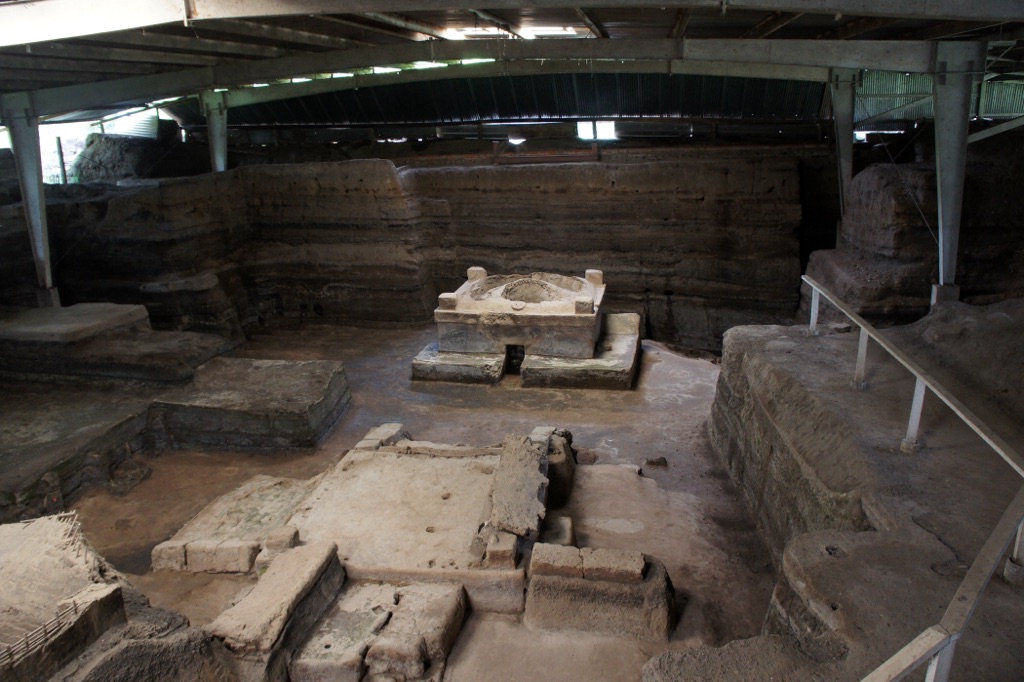The Joya de Ceren Archaeological Site in El Salvador is a remarkably well-preserved snapshot of daily life in a pre-Columbian Mesoamerican farming community. Often referred to as the “Pompeii of the Americas,” it was buried under a volcanic eruption around 600 AD. The site provides invaluable insights into the domestic, religious, and social structures of the people who lived there. Unlike other archaeological sites in the region, Joya de Ceren offers a unique perspective on the non-elite classes of ancient Mesoamerican society.
Get your dose of History via Email
Historical Background of Joya de Ceren Archaeological Site
Archaeologists stumbled upon Joya de Ceren in 1976 during a government-led project. It was Payson Sheets, an anthropologist, who recognized its significance. The site was a pre-Hispanic farming village, preserved under layers of volcanic ash from the Loma Caldera eruption. The Maya people, known for their sophisticated culture and written language, built and inhabited the site. Joya de Ceren was not a major ceremonial center but a community of ordinary people, which makes it extraordinary for understanding everyday life in that era.
The village was not re-inhabited after the eruption, preserving its state for centuries. This lack of subsequent occupation has allowed for an undisturbed window into the past. The site’s discovery was a stroke of luck, as it was nearly destroyed by bulldozing before its significance was understood. Joya de Ceren has since become a key site for studying the Maya civilization, providing a contrast to the more commonly explored elite-centric sites.
Excavations have revealed that the inhabitants had little time to flee, leaving behind artifacts that depict a moment frozen in time. The site has yielded residential structures, storehouses, workshops, kitchens, and a religious structure. These findings suggest that Joya de Ceren was a thriving community engaged in various aspects of daily life, from agriculture to religious practices.
While Joya de Ceren may not have been the scene of grand historical events, its importance lies in the mundane. The site offers a rare glimpse into the lives of the Maya working class, their living conditions, and their interactions with the environment. It is a testament to the resilience of everyday life amidst the forces of nature.
The preservation of Joya de Ceren has been so exceptional that it was declared a UNESCO World Heritage Site in 1993. This recognition underscores the site’s value for understanding the cultural and historical context of the Maya civilization and its everyday citizens.
About Joya de Ceren Archaeological Site
Joya de Ceren’s layout includes several structures typical of a Maya farming village. The buildings were constructed using a variety of materials, including adobe, wood, and thatch. The architecture reflects the adaptation to the local environment and the needs of its inhabitants. The site includes residential buildings, communal areas, storage facilities, and a sauna-like structure known as a temazcal.
The residential structures at Joya de Ceren are modest yet significant. They provide a window into the domestic life of the Maya. The buildings often included sleeping areas, storage spaces, and areas for food preparation. The construction methods used were effective in creating a comfortable living space that withstood the tropical climate.
The communal areas of Joya de Ceren suggest a society that valued collective activities. These spaces were likely used for various communal tasks, such as food processing or craftwork. The presence of storage facilities indicates a community that planned for the future, storing food and goods for times of need.
The temazcal at Joya de Ceren is particularly intriguing. This steam bath was used for health and religious purposes, reflecting the holistic approach to well-being in Maya culture. The construction of the temazcal was sophisticated, with a system to generate steam and control temperature.
The site’s architectural highlights are not just in the buildings themselves but in their contents. Household items, such as ceramics, tools, and even food remnants, have been found in situ. These artifacts provide a direct link to the daily activities and cultural practices of the Maya people who once lived there.
Theories and Interpretations
Several theories have emerged about the use and significance of Joya de Ceren. One theory suggests that the site was a typical farming village that played a crucial role in supporting the larger, nearby ceremonial centers. The well-preserved nature of the site has led to interpretations of the social and economic organization of the community.
Some mysteries remain about Joya de Ceren, such as the exact relationship between this village and the broader Maya civilization. The site’s preservation has allowed for detailed interpretations of the agricultural practices of the Maya, including crop types and farming techniques. However, the full extent of the village’s trade and interaction with other communities is still being explored.
Archaeologists have used various methods to date and understand Joya de Ceren. Radiocarbon dating has been instrumental in establishing the timeline of the village’s occupation and destruction. The volcanic ash has also provided a precise stratigraphic record that aids in dating the site.
Theories about the religious practices at Joya de Ceren are based on the artifacts and structures found. The presence of a religious building and the temazcal suggests that ritual activities were integrated into daily life. The exact nature of these rituals and their significance to the community is a subject of ongoing research.
Interpretations of Joya de Ceren continue to evolve as new discoveries are made. Each artifact and structure adds to the understanding of this unique site. The ongoing work of archaeologists and researchers is crucial in piecing together the lives of the Maya people who once called Joya de Ceren home.
At a glance
Country: El Salvador
Civilization: Maya
Age: Approximately 1400 years old (around 600 AD)

